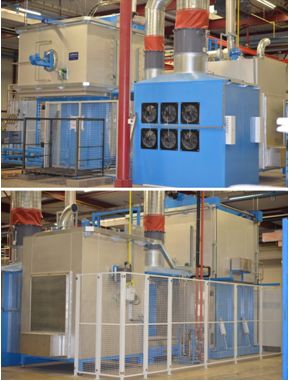 Gli scambiatori di calore in alluminio sono realizzati in diversi modi; non tutti i procedimenti sono uguali.
Gli scambiatori di calore in alluminio sono realizzati in diversi modi; non tutti i procedimenti sono uguali.
I processi di produzione NRF utilizzano la brasatura a controllo di atmosfera, conosciuta come CAB, per garantire agli scambiatori di calore la più alta qualità possibile.
Processo
Tutti i processi di brasatura devono garantire che i componenti metallici siano protetti da corrosioni che possono verificarsi durante e in seguito al processo. La corrosione può essere causata principalmente da contaminanti e ossigeno presenti nell’atmosfera di brasatura, ma può anche derivare dal liquido utilizzato durante il processo. Il processo che ottimizza al meglio sia le condizioni atmosferiche che la riduzione del liquido utilizzato, favorisce una produzione migliore in termini di resistenza e alta qualità. Il processo di brasatura CAB è riconosciuto ad oggi il metodo migliore per la brasatura dell’alluminio degli scambiatori di calore. In camera di brasatura il sistema CAB sostituisce l’atmosfera con gas industriali, ciò costituisce migliore trasferimento di calore al materiale e il liquido favorisce la brasatura nelle congiunzioni.
Vantaggi per il cliente
NRF ha investito in 3 nuovi forni di brasatura Rame/Ottone per ciascuno dei nostri impianti di produzione Rame/Ottone in tutta Europa. NRF ha investito oggi in un forno completamente nuovo di brasatura alluminio per la produzione di Placche e Barré in sede centrale a Mill, Olanda. A partire da metà Dicembre, tutti i prodotti Placche e Barrè sono stati brasati in questo nuovo forno a tecnologia CAB. Il nuovo forno conferisce maggiore capacità produttiva e molteplici vantaggi di supporto a servire i nostri clienti. Migliore qualità del prodotto finale si ha in merito allo “stato dell’ arte” del processo di controllo, alla posizione verticale di brasatura, al ridotto contenuto di ossigeno e ai tempi ridotti di brasatura.
Siamo convinti che i clienti avranno un’esperienza garantita e un ottimo risultato nel prodotto finito Placche e Barré. E’ obiettivo di NRF migliorare costantemente la soddisfazione dei nostri clienti.
EN
Aluminium heat exchangers are manufactured in many different ways; not all processes are equal. NRF’s manufacturing process uses Controlled Atmosphere Brazing, also known as CAB, to ensure that your heat exchanger is the highest quality possible.
Process
All brazing processes have to ensure that the metal components are protected from corrosion that can occur both during and after the process. Corrosion primarily comes from contaminates and oxygen in the brazing atmosphere but can also come from the flux that is required in the brazing process. The process that does the best job of controlling atmospheric conditions and minimizes the use of flux produces the highest quality parts. The CAB brazing process is now the preferred method for aluminium brazing of heat exchangers. CAB replaces the atmosphere in the furnace chamber with industrial gases allowing better heat transfer to the material and the flow of the brazing material into the joints.
Customer advantages
NRF has invested in 3 new Copper Brass brazing furnaces for each of our Copper Brass production plants throughout Europe. NRF has now invested in a whole new brazing furnace for the aluminium Bar and Plate production facility in Mill, the Netherlands. From mid-December on, all Bar and Plate products are brazed in this new CAB brazing furnace. The new furnace gives far greater production capacity and has many advantages that help us better serve our customers. Better end-product quality is produced because of “state of the art” process control, vertical brazing position, minimized oxygen content and shorter brazing time. We are convinced that customers will experience guaranteed quality and great appearance in our latest Bar and Plate products. It is NRF’s aim to constantly improve our customer’s satisfaction.






